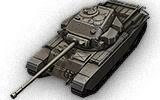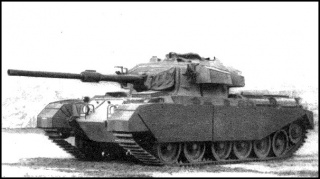Centurion Mk. 7/1
GB24_Centurion_Mk3 (Stock)
| 3515000 가격 |
| 1620 내구력 |
| 51.42 / 51.5 kg중량 |
- 지휘관
| 120.7/50.8/31.8차체 장갑(정면/측면/후면, mm) |
| 152.4/88.9/88.9포탑 장갑(정면/측면/후면, mm) |
| 650 마력엔진 출력 |
| 40 km/h최대 속력 |
| 30 도/초회전 속도 |
| 230 기본 포탄 공격력 |
| 226 mm기본 포탄 관통력 |
| 6 재장전 시간 |
| 36 도/초포탑 회전 속도 |
| 400 m관측 범위 |
| 550 m통신 범위 |

The Centurion Mk. 7/1 was the ancestor of the MBTs (main battle tanks). It takes the features of the Mk. I, adopts them and improves upon them greatly. While its propensity for module and crew damage seems to remain, the new Centurion has somewhat tougher armor both on the hull and turret, which combines with the good gun depression and quick acceleration to make it an even fiercer hill-climber. But probably most significant is the fact that it is able to mount the Tier X caliber 105mm L7A1 cannon; as the [Type 61] and the Leopard prototyp A (which shares the same 105mm L7A1) are the only colleagues with a tier 10 gun, the Mk. 7/1 possesses a significant edge in terms of alpha damage and penetration. Thanks to its gun, this tank is able to provide top-tier fire support, and should have no problem contributing to a team above its own tier if it hangs back slightly.
Compatible Equipment
Compatible Consumables
Player Opinion
Pros and Cons
Pros:
- L7A1 gun; the best of its era for many years in real life, is insane for its tier
- Turret armor (Since changes to turret in patch 9.0, turret is vulnerable to ~200+ pen rounds)
- Maneuverability
- Gun depression and aim time
- High penetration values on the standard and prem HESH rounds can be used to one-shot tier IX artillery (480 alpha)
Cons:
- Poor hull armor
- Bulky and visible
- Crew and module damage
- Sluggish top speed
- Slow reload with the 105mm L7A1 compare to other tier 9 mediums (10.12s for 100% crew, 9.90s with 100% crew and BiA, and 9.45s with all the bonuses)
Performance
The key to playing this tank is taking all the lessons learned from the Comet and the Centurion Mk. I and applying them to an even further extent. Your gun is sure to be the quickest and might even be the most hard-hitting on your entire team, and you have the ability to take cover very well, so make use of this. Unlike the Cromwell and Comet, you should not even consider acting as a scout, since your cannon is much too valuable to be lost in an early skirmish. Instead, follow the main line and set up deadly long-range fire support, using cover at every opportunity. Your gun's brilliant aim time and high muzzle velocity also makes you a very effective scout-killer.
Early Research
- Suspension
- B-barrel cannon
- Upgraded turret
- L7A1 cannon
- Engine
- Radio
Historical Info
Development history
The department responded by extending the long-travel five-wheel suspension used on the Comet with the addition of a sixth wheel and an extended spacing between the second and third wheels. The Christie suspension, with vertical spring coils between side armour plates, was replaced by a Horstmann suspension with external horizontal springs. The hull was redesigned with welded, sloped armour and featured a partially cast turret with the highly regarded 17 pounder as the main gun and a 20 mm Polsten cannon in an independent mounting to its left. With a Rover-built Rolls-Royce Meteor as used on the Comet and Cromwell, the new design would have excellent performance.
Shortly after the programme commenced, it became clear that the requirement to withstand 88 mm weapons would be impossible to meet within the permitted weight. The original specification had been set so that the A41 could be carried on the existing Mark I and Mark II transport trailers, which were limited to a 40-ton load. The War Ministry decided it would be wiser to build new trailers, rather than hamper what appeared to be a superb design. Even before prototypes of the original 40-ton design were completed, the design of a heavier version was well under way. The new version carried armour equal to the heaviest infantry tanks, and cross-country performance was superior to even the early cruiser tanks. The A41 was the first British tank that could "do it all", leading to the new designation "universal tank". The design mockup built by AEC Ltd was viewed in May 1944. Subsequently twenty pilot models were ordered with various armament combinations: ten with 17 pdr and 20mm Polsten gun of which half had a Besa machine gun in the turret rear and half an escape door, five with 17pdr and forward Besa and escape door, and five with QF 77mm gun and driver-operated hull machine gun. Prototypes of the original 40-ton design, the Centurion Mark I, had 76 mm of armour in the front glacis, which was thinner than the then current infantry tank designs such as the Churchill which had 101 mm, but the glacis plate was highly sloped and so the effective thickness of the armour was very high—a design feature shared by other effective designs such as the German Panther tank and Soviet T-34. The turret was extremely well armoured at 152 mm. The tank was also highly mobile, and easily outperformed the Comet in most tests. The uparmoured Centurion Mark II soon arrived; it had a new 118 mm-thick glacis and the side and rear armourhad been increased from 38 mm to 51 mm. Only a handful of Mk I Centurions had been produced when the Mk II replaced it on the production lines. Full production began in November 1945 with an order for 800 on production lines at Leyland Motors, Lancashire the Royal Ordnance Factories at Leeds and Woolwich, and Vickers at Elswick. The tank entered service in December 1946 with the 5th Royal Tank Regiment.
Soon after the Centurion's introduction, Royal Ordnance finished work on the Ordnance QF 20 pounder (84 mm) tank gun. By this point the usefulness of the 20 mm Polsten had been called into question, it being unnecessarily large for use against troops, so it was replaced with a Besa machine gun in a completely cast turret. The new Centurion Mark III also featured a fully automatic stabilisation system for the gun, allowing it to fire accurately while on the move, dramatically improving battlefield performance. Production of the Mk 3 began in 1948. The Mk 3 was so much more powerful than the Mk 1 and Mk 2 that the earlier designs were removed from service as soon as new Mk 3s arrived, and the older tanks were then either converted into the Centurion Armoured Recovery Vehicle (ARV) Mark 1 for use by the Royal Electrical and Mechanical Engineers or upgraded to Mk 3 standards. Improvements introduced with the Mk 3 included a more powerful version of the engine and a new gunsight and gun stabiliser. The 20 pounder gun was used only for a short time, until the Royal Ordnance Factories introduced the now legendary 105 mm L7 gun. All later variants of the Centurion, from Mark 5/2 on, used the L7. Design work for the Mk 7 was completed in 1953 with production beginning soon afterwards.
The Centurion was used as the basis for a range of specialist equipment, including combat engineering variants with a 165 mm demolition gun Armoured Vehicle Royal Engineers (AVRE). It is one of the longest-serving designs of all time, serving as a battle tank for the British and Australian armies from the Korean War (1950–1953) to the Vietnam War (1961–1972), and as an AVRE during the Gulf War in January–February 1991.
Historical Gallery
| Light Tanks | |
| Medium Tanks | |
| Heavy Tanks | |
| Tank Destroyers | |
| Self-Propelled Artillery |
| USA | |
| UK | |
| Germany | |
| USSR | |
| China | |
| Japan |
